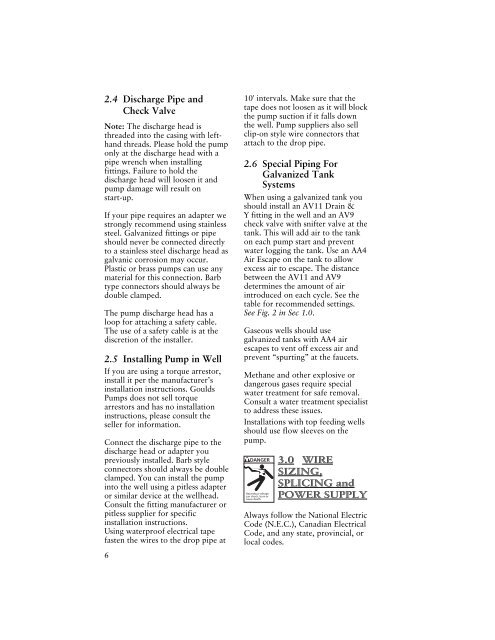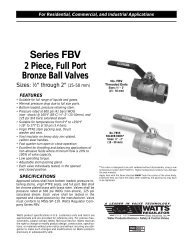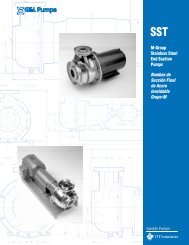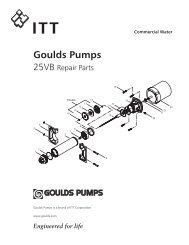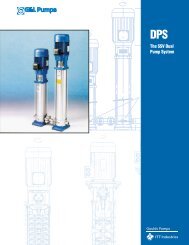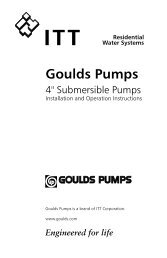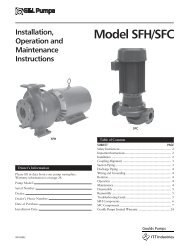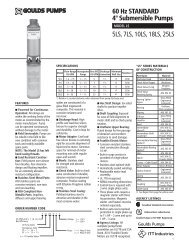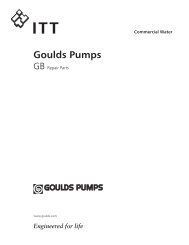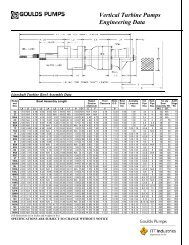4" Submersible Pumps
4" Submersible Pumps
4" Submersible Pumps
Create successful ePaper yourself
Turn your PDF publications into a flip-book with our unique Google optimized e-Paper software.
2.4 Discharge Pipe and<br />
Check Valve<br />
Note: The discharge head is<br />
threaded into the casing with lefthand<br />
threads. Please hold the pump<br />
only at the discharge head with a<br />
pipe wrench when installing<br />
fittings. Failure to hold the<br />
discharge head will loosen it and<br />
pump damage will result on<br />
start-up.<br />
If your pipe requires an adapter we<br />
strongly recommend using stainless<br />
steel. Galvanized fittings or pipe<br />
should never be connected directly<br />
to a stainless steel discharge head as<br />
galvanic corrosion may occur.<br />
Plastic or brass pumps can use any<br />
material for this connection. Barb<br />
type connectors should always be<br />
double clamped.<br />
The pump discharge head has a<br />
loop for attaching a safety cable.<br />
The use of a safety cable is at the<br />
discretion of the installer.<br />
2.5 Installing Pump in Well<br />
If you are using a torque arrestor,<br />
install it per the manufacturer’s<br />
installation instructions. Goulds<br />
<strong>Pumps</strong> does not sell torque<br />
arrestors and has no installation<br />
instructions, please consult the<br />
seller for information.<br />
Connect the discharge pipe to the<br />
discharge head or adapter you<br />
previously installed. Barb style<br />
connectors should always be double<br />
clamped. You can install the pump<br />
into the well using a pitless adapter<br />
or similar device at the wellhead.<br />
Consult the fitting manufacturer or<br />
pitless supplier for specific<br />
installation instructions.<br />
Using waterproof electrical tape<br />
fasten the wires to the drop pipe at<br />
6<br />
10' intervals. Make sure that the<br />
tape does not loosen as it will block<br />
the pump suction if it falls down<br />
the well. Pump suppliers also sell<br />
clip-on style wire connectors that<br />
attach to the drop pipe.<br />
2.6 Special Piping For<br />
Galvanized Tank<br />
Systems<br />
When using a galvanized tank you<br />
should install an AV11 Drain &<br />
Y fitting in the well and an AV9<br />
check valve with snifter valve at the<br />
tank. This will add air to the tank<br />
on each pump start and prevent<br />
water logging the tank. Use an AA4<br />
Air Escape on the tank to allow<br />
excess air to escape. The distance<br />
between the AV11 and AV9<br />
determines the amount of air<br />
introduced on each cycle. See the<br />
table for recommended settings.<br />
See Fig. 2 in Sec 1.0.<br />
Gaseous wells should use<br />
galvanized tanks with AA4 air<br />
escapes to vent off excess air and<br />
prevent “spurting” at the faucets.<br />
Methane and other explosive or<br />
dangerous gases require special<br />
water treatment for safe removal.<br />
Consult a water treatment specialist<br />
to address these issues.<br />
Installations with top feeding wells<br />
should use flow sleeves on the<br />
pump.<br />
DANGER<br />
Hazardous voltage<br />
can shock, burn or<br />
cause death.<br />
3.0 WIRE<br />
SIZING,<br />
SPLICING and<br />
POWER SUPPLY<br />
Always follow the National Electric<br />
Code (N.E.C.), Canadian Electrical<br />
Code, and any state, provincial, or<br />
local codes.


